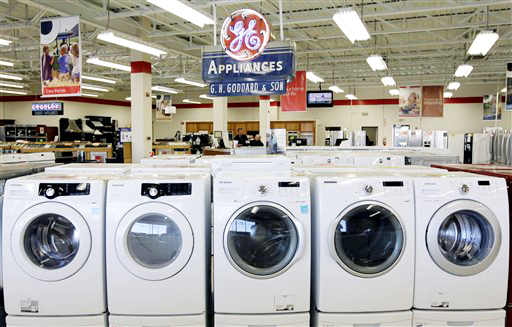WASHINGTON — The U.S. economy grew at a slightly faster 2 percent annual rate from July through September, buoyed by more spending by consumers and the federal government.
Even with the increase from a 1.3 percent growth rate in the April-June quarter, the economy remains too weak to rapidly boost job creation.
The report Friday from the Commerce Department is the last broad snapshot of the economy before Americans choose a president in 11 days.
Republican nominee Mitt Romney has attacked President Barack Obama’s handling of the economy and has noted that growth has slowed from last year. The 1.74 percent annual growth rate for the first nine months of 2012 remains slightly behind last year’s 1.8 percent growth. That, in turn, trailed 2010’s growth of 2.4 percent.
Obama has argued that the economy is steadily improving. Analysts cautioned, though, that Friday’s report offered few signs that economic growth is gaining momentum.
“We suspect that growth will slow a little in the fourth quarter and expect it to remain close to 2 percent next year,” said Paul Ashworth, chief U.S. economist at Capital Economics.
The economy grew faster last quarter in part because consumer spending rose at a 2 percent annual rate, up from a 1.5 percent rate in the second quarter. Spending on homebuilding and renovations increased at an annual rate of more than 14 percent.
And federal spending surged, mainly because of the sharpest increase in defense spending in more than three years.
Growth was held back by the first drop in exports in more than three years and flat business investment in equipment and software. It was also slowed by the effects of the drought that struck the Midwest last summer. The drought cut agriculture stockpiles and reduced the economy’s annual growth rate by nearly a half-point.
Once crop supplies return to normal, they will help boost economic growth, analysts noted.
The government’s report covers gross domestic product. GDP measures the nation’s total output of goods and services — from restaurant meals and haircuts to airplanes, appliances and highways.
It was the government’s first of three estimates of growth for the July-September quarter. And it sketched a picture that’s been familiar all year: The economy is growing at a tepid rate, slowed by high unemployment and corporate anxiety over an unresolved budget crisis and a slowing global economy.
It is unclear what effect, if any, Friday’s report might have on the presidential race. Some analysts said they doubted it would sway many undecided voters in battleground states.
“It’s moving in the right direction, but it’s still an unimpressive number,” says Larry Sabato, director of the University of Virginia’s Center for Politics. “It’s so close to the election I don’t know how many people are left to influence.”
The factors supporting the economy’s growth are shifting. Exports and business investment drove much of the growth after the Great Recession officially ended in June 2009. But those sectors are weakening. Consumer spending, meantime, has picked up. And housing is adding to growth after a six-year slump.
The number of homes available for sale has fallen since the recession, helping push up prices. That trend has also supported an increase in home construction, though from very low levels.
Consumer spending drives nearly 70 percent of economic activity.
Businesses have grown more cautious since spring, in part because customer demand has remained modest and exports have declined as the global economy has slowed.
Many companies worry that their overseas sales could dampen further if recession spreads throughout Europe and growth slows further in China, India and other developing countries. Businesses also fear the tax increases and government spending cuts that will kick in next year if Congress doesn’t reach a budget deal.
Those trends have made companies reluctant to hire or invest in expensive equipment.
Since the recovery began more than three years ago, the U.S. economy has grown at the slowest rate of any recovery in the post-World War II period. And economists think growth will remain sluggish at least through the first half of 2013.
Some analysts believe the economy will start to pick up in the second half of next year.
Economists hope that by then, the tax and spending confrontations that have brought gridlock to Washington should be resolved. That could encourage businesses to invest and hire.
The Federal Reserve’s continued efforts to boost the economy by lowering long-term interest rates may also help by generating more borrowing and spending by consumers and businesses.
But the economy is still being slowed by consumers’ efforts to spend less, boost savings and pay off debts, economists say. And banks remain cautious about lending in the aftermath of the financial crisis. That’s why recoveries after financial crises are usually weak, many economists say.
“There’s just a reality here: You don’t recover from these types of events as quickly as you’d like,” said Paul Edelstein, an economist at IHS Global Insight.
Copy the Story Link
Send questions/comments to the editors.



Success. Please wait for the page to reload. If the page does not reload within 5 seconds, please refresh the page.
Enter your email and password to access comments.
Hi, to comment on stories you must . This profile is in addition to your subscription and website login.
Already have a commenting profile? .
Invalid username/password.
Please check your email to confirm and complete your registration.
Only subscribers are eligible to post comments. Please subscribe or login first for digital access. Here’s why.
Use the form below to reset your password. When you've submitted your account email, we will send an email with a reset code.